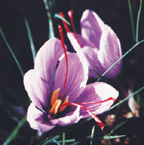|

Spring 2002 (10.1)
Page
62
A Cure For Cancer?
Studying
the Medicinal Effects of Saffron
by Dr. Fikrat Abdullayev
  In this issue, we've taken a look at
Azerbaijanis living abroad who have made important contributions
to the world of Azerbaijani music, art, dance and culture. This
article, on the other hand, tells of an Azerbaijani in Mexico
who is using his education and expertise to do mainstream research
about the world's most deadly disease: cancer. In this issue, we've taken a look at
Azerbaijanis living abroad who have made important contributions
to the world of Azerbaijani music, art, dance and culture. This
article, on the other hand, tells of an Azerbaijani in Mexico
who is using his education and expertise to do mainstream research
about the world's most deadly disease: cancer.
______
From ancient times, saffron
(Crocus sativus L.) has not only been used as a spice for flavoring
food like rice, but also to treat various human diseases. Folklore
tells us that saffron has been used throughout the ages to treat
the nervous system (insomnia, paralysis), the respiratory system
(asthma, colds), the cardiovascular system (heart disease), the
digestive system (stomach disorders, flatulence, colic), the
genitourinary system and ailments such as scarlet fever, smallpox,
gout and eye disease.
Since 1990, I've been carrying out research to determine if saffron
can be used to cure or prevent cancer, which claims more than
5 million lives each year throughout the world, more than any
other disease or cause of death.
 Saffron is harvested from the dried,
dark red stigmas of crocus flowers. Since its tiny filaments
must be painstakingly harvested by hand, it's no surprise that
it ranks as the world's most expensive spice. Worldwide, 50 tons
of saffron are produced each year, for a total of about $50 million.
Saffron is cultivated in Azerbaijan, France, Greece, India, Iran,
Italy, Spain, China, Israel, Morocco, Turkey, Egypt and Mexico. Saffron is harvested from the dried,
dark red stigmas of crocus flowers. Since its tiny filaments
must be painstakingly harvested by hand, it's no surprise that
it ranks as the world's most expensive spice. Worldwide, 50 tons
of saffron are produced each year, for a total of about $50 million.
Saffron is cultivated in Azerbaijan, France, Greece, India, Iran,
Italy, Spain, China, Israel, Morocco, Turkey, Egypt and Mexico.
I began investigating the biological activity of saffron while
working at New Jersey State University (Rutgers). In 1995, I
received an invitation from the Mexican Ministry of Science and
Technology (CONACYT) to work in Mexico. At present, I am working
in Mexico City. Our laboratory cooperates with Azerbaijan's Institute
of Botany.
After reviewing the prior test tube and animal studies using
saffron as either a cancer preventive or cancer treatment, I
found that saffron not only inhibited the formation of new cancers,
but in many different types of studies also shrunk existing tumors.
In addition, saffron at times appears to enhance the anticancer
effect of chemotherapy.
These effects may be due to saffron's high concentration of molecules
called carotenoids, which possess chemopreventive properties.
Chemoprevention is defined as the use of synthetic or natural
agents to block the development of cancer in human beings. Other
carotenoids include beta-carotene and lycopene, which also have
been shown to have chemopreventive properties.
  Where does that leave us? At this point,
comprehensive, in-depth studies still need to be conducted to
define the mechanisms involved in the therapeutic properties
of saffron, investigate the mechanisms involved in saffron cancer
chemoprevention and determine the biologically active components
of saffron. We also need to perform human studies to define the
efficacy of saffron in cancer treatment and prevention. Where does that leave us? At this point,
comprehensive, in-depth studies still need to be conducted to
define the mechanisms involved in the therapeutic properties
of saffron, investigate the mechanisms involved in saffron cancer
chemoprevention and determine the biologically active components
of saffron. We also need to perform human studies to define the
efficacy of saffron in cancer treatment and prevention.
Even if saffron does in fact have these therapeutic properties,
its supplies are still limited and expensive. The scarcity and
expense of obtaining large quantities of saffron may provide
impediments for human chemoprevention and cancer treatment. Perhaps
an indoor cultivation method will one day prove advantageous
in achieving the highest quality of saffron and result in reducing
its costs.
Dr. Fikrat Abdullayev has a Ph.D. from the Institute of Botany
at the Azerbaijan Academy of Sciences and a doctorate in Biological
Sciences from the Ukrainian Academy of Sciences in Kiev. He is
currently head of the experimental Oncology Laboratory at the
National Institute of Pediatrics in Mexico City. Contact him
at: Laboratorio Oncología Experimental, Instituto Nacional
de Pediatria, Av. Insurgentes Sur, 3700-C, 04530 México
D.F., Mexico. Tel: (525) 606-0002; Fax: (525) 506-9455; fikrat@servidor.unam.mx
or fikrat@yahoo.com.
____
Back to Index
AI 10.1 (Spring 2002)
AI Home
| Magazine
Choice
| Topics
| AI Store | Contact us
Other Web sites
created by Azerbaijan International
AZgallery.org | AZERI.org | HAJIBEYOV.com
|


